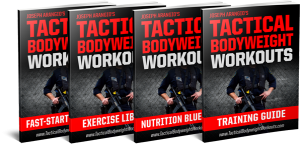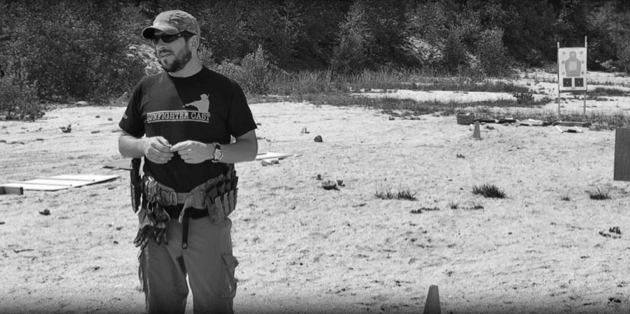Daniel Shaw is a 16-year Marine infantry combat veteran, firearms trainer at Thunderbird Tactical, and co-host of Gunfighter Cast.
In this Interrogation Interview, Shaw shares his insights on the importance of training like you fight. He also talks about the one thing you must have if you want to be prepared for the unexpected (Hint: it’s not tactical gear).
JOSEPH ARANGIO: Provide examples of real-world bodyweight-only workouts military operators are doing in the field.
DANIEL SHAW: Circuit-style workout routines are incredibly popular in the field. We are able to find ledges to use as pull up bars, do various angle pushups, squats, situps, crunches, handstand pushups, one-leg squats, dips, etc.
If we become relatively stationary, workout items begin to magically appear. Someone finds something to use as a weight bar, another guy snakes a tire from the motor pool, and next thing you know — you have a gym.
We also always have ways to increase weight and make a workout more challenging. Wearing full kit, incorporating the rifle into the workout, or just simply carrying ammo or water cans.
JA: How important is it to train in your full gear, in order to prepare you for the demands of an extra 50-75 pounds of kit?
DS: Combat load is dependent upon missions and specific roles in that mission.
During my years of active duty, my bodyweight ranged from 160-180 pounds. Combat loads that I would carry varied greatly, with as low as 60 pounds and as high as 175 pounds. Everything in the aforementioned range is incredibly significant to a man of my size.
If the first time you run with all your gear on is the same time your life depends on it, you have failed yourself and your brothers by becoming a liability instead of an asset.
Adding weight to any part of the body will increase the stress on every part of the body with some parts feeling more than others. Simply put: Condition yourself for how you will fight.
JA: Any thoughts on how to decrease the chance of landing-type injuries? Like when you jump from a truck bed and sprain a knee or ankle.
DS: That’s a difficult question. As leaders, we try to constantly reinforce the idea of physical safety through policy, rehearsals, and teamwork, but circumstances often arise that are seemingly unavoidable.
There is a balance that has to be found in safety with respect to tactics. For example, jumping rooftop to rooftop was a sound entry tactic used during Operation Phantom Fury during the battle of Fallujah. The tactic likely saved lives of Marines and made their entry more combat effective, but there were some cases where Marines fell and were hurt fairly badly.
Simple things like getting out of a 7-ton truck become very dangerous when each person is carrying extra weight and cumbersome gear and armor. Just like a workout, it is important to rehearse and rep the little things to insure they are done quickly and safely.
JA: How important is it to train in an “adrenalized” state? In other words, getting your heart rate above 165 bpm in order to prepare for the adrenaline dump that happens when the enemy is trying to kill you.
DS: I believe that training should be realistic and challenging or it is not training. One thing that combat arms Soldiers, Sailors, Airmen and Marines do right is place emphasis on physical fitness. This is one area that I believe is incredibly overlooked by a large majority of armed citizens who have accepted the responsibility for their own personal safety and own or carry firearms on a daily basis.
It doesn’t matter if you are in a static 10 second fight or if you fight for 3 minutes and move 200 yards during the fight, you are going to be winded and your body will be feeling a great deal of physiological stress. It is important for us to inoculate ourselves the best we can to the effects of prolonged increased heart rate, adrenaline dump, and chemicals our brain produces during times of high stress.
We also must develop mental toughness and pain tolerance. Artificially recreating the feelings I have experienced in combat seems impossible, but I feel that I get the closest to it by running long distances at faster paces than I am comfortable with, circuit training targeted for the entire body while pushing myself harder and longer than I think I can go.
JA: How do you prepare your body to focus your vision, calm breathing, and concentrate in order to place a bullet on target… while in this adrenalized state?
DS: First it all comes back to training, and I am firm believer in muscle memory baring a semantics argument. The goal with training any new skill is to achieve unconscious competence or what the Japanese refer to as “mushin” or “without thought.”
An accomplished fighter or shooter should not have to think about every action that is included in the process of a shot. I personally use and teach shooters to keep breathing as much as possible and to interrupt the breathing cycle at the instant the shot is taken. Engage your mind before your weapon and remember to breath.
JA: What future trends do you see regarding tactical strength and conditioning?
DS: I see more products, like suspension straps, coming about to allow a minimalist, such as myself, to pack equipment to use anywhere in a quick workout. There is also, as I see it, a disparity between those who go to the gym for big gains and muscle definition and those who seek a more functional fitness level for a specific job or lifestyle.
I would like to see the two come closer together and the functional fitness crowd get more recognition from supplement developers so they can produce products that help us achieve our work related fitness goals.
JA: List the top-10 tactical gear items every prepared citizen should own.
DS: If I had to list 10 things, from a preparedness standpoint, I would say: have a plan, water, food, shelter, medical (within your skill level), medications, ammunition, a long gun, a handgun, ammunition, and a survival mindset.
Truth is, many people are so caught up in tangible goods that we completely miss what’s important.
Assuming a gun is already owned, the prepared citizen will seek training to maximize his or her potential with numerous firearms as well as defensive tactics. Training doesn’t only apply to firearms.
As I mentioned in my short non-list, med kits are necessities, but to an individual that understands his or her med kits – the world is a medical kit. The reality is that we are much more likely to be involved in a medical emergency than a gunfight.
What every prepared citizen should possess is the will and knowledge necessary to maintain a healthy body and mind.
I don’t care how fast and accurate you are at the local gun club match, I want to see how you employ your weapon under the worst of conditions and extreme physical exertion. I have personally talked with grossly overweight students about the idea that they will die of a heart attack far before ever getting into a gunfight.
I said all this to say stop buying the latest piece of gear you see instructor X wear and go learn to use what you have, then you will know exactly what you need.
 Joseph Arangio, MS, CSCS, is a tactical strength and conditioning coach and author of Tactical Bodyweight Workouts.
Joseph Arangio, MS, CSCS, is a tactical strength and conditioning coach and author of Tactical Bodyweight Workouts.
